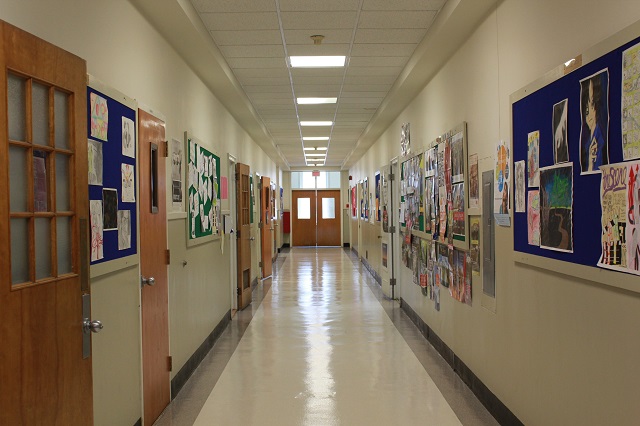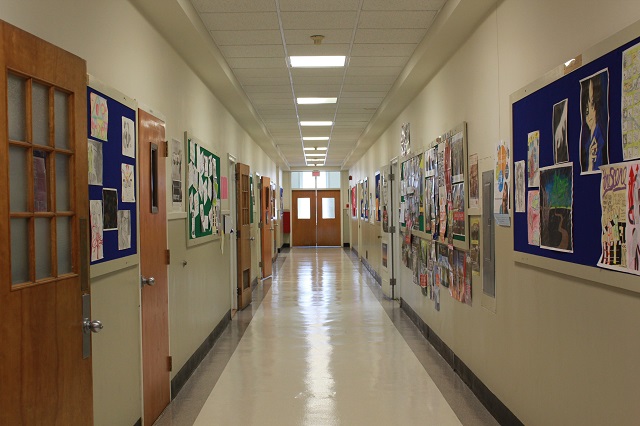
 Donald Trump and his choice of Michigan billionaire Betsy DeVos as education secretary — a woman with no teaching experience, who sent her own kids to private schools — may not find the anticipated teacher shortfall troubling. The rest of us, however, should be deeply concerned. (Photo: SOMANEDU / Flickr)
Donald Trump and his choice of Michigan billionaire Betsy DeVos as education secretary — a woman with no teaching experience, who sent her own kids to private schools — may not find the anticipated teacher shortfall troubling. The rest of us, however, should be deeply concerned. (Photo: SOMANEDU / Flickr)
Teacher Libby Garland vividly recalls the excitement she felt when she was accepted into the New York City Teaching Fellows Program in 2005. The program’s mission, “preparing a group of exceptional teachers committed to a better future for the NYC students who need them most,” seemed like a perfect fit, and she was pleased to get a position in the School for Democracy and Leadership in Brooklyn.
The school was then in its second year, and Garland was assigned to teach social studies to tenth graders.
“It was a very idealistic project staffed by a bunch of bright, committed people who saw social justice as central to education,” Garland told Truthout. “Everyone, including the principal, really cared about the kids.” Despite this, Garland said, problems were immediately evident. For example, it took until late October for the Department of Education to provide Garland with textbooks. “Every night at 9:00 p.m. I’d find myself in Office Max making copies of readings and assignments, paying for them myself,” she said. “Everyone in there at that hour was also a teacher.”
Eighteen-hour workdays were common. “It was a really brutal lesson,” Garland said. “Having smart, dedicated and hard-working teachers is not enough. The school was chaotic. Things rolled along without systems in place — even something as basic as taking attendance fell through the cracks — and many of the students simply got caught in the chaos.”
By the end of her first year, Garland decided she’d had enough. “The despair I felt, which may have been because of my own flawed expectations about what I could do, combined with the sheer intensity of issues the students and their families were going through — everything from homelessness to arrests to illnesses — was too much.”
High Teacher Attrition Rates
Garland now teaches history at a large, urban, community college, which she finds more congenial. Nonetheless, since the need for good public educators remains acute, she periodically wonders if she made the right choice. In fact, since approximately eight percent of teachers, both new and experienced, leave the field each year, she worries about the predicted shortage of public school educators. American Federation of Teachers president Randi Weingarten calls it a “brain drain unseen in any other profession,” and notes that the figure is more than double that of doctors, lawyers, engineers, nurses or architects. That’s why Weingarten, the American Federation of Teachers, and other educational advocacy groups are warning lawmakers about a growing teacher shortage, a gap that could result in 112,000 open teaching slots by 2018.
The National Center for Education Statistics, a federal entity, attributes the predicted shortfall not only to teachers leaving the classroom, but also to a diminishing number of education majors. What’s more, the anticipated deficit is projected to coincide with a dramatic increase in public school enrollment, from 50.4 million today to 51.4 million by 2026. Already, Colorado, Idaho, Nevada, North Dakota, Texas and Utah have seen a significant spike. At the same time, the trend is not universal, and the states of Connecticut, Michigan, New Hampshire, Rhode Island and Vermont expect to see the number of registered students decline over the same timeframe.
Donald Trump and his choice of Michigan billionaire Betsy DeVos as education secretary — a woman with no teaching experience, who sent her own kids to private schools — may not find the anticipated shortfall troubling. The rest of us, however, should be deeply concerned.
Indeed, the reasons why teachers are leaving — or not going into teaching in the first place — are not difficult to discern. Teachers unions, as well as activist groups like the Badass Teachers Association and research entities like the Learning Policy Institute agree: Micromanagement of teachers; disorganized school administration; a lack of voice in matters affecting school functioning; too few chances to teach collaboratively; excessive attention to test prep; chronic underfunding; and a perceived lack of respect from parents and the overall community lead to demoralization and push educators into less emotionally exhausting, and often better paying, occupations.
Let’s start with salaries. Statistics from the 2012-13 academic year show that starting high school teacher salaries ranged from $27,274 in Montana to $43,235 in Maryland. There is also a huge span for veteran educators, with the median salary of the best-paid high school educators hitting $88,000 while the worst were stuck at less than $38,000. Pensions are also an issue since most are not portable, meaning that if teachers move from one state to another, their pensions do not always travel with them.
All of this, said Linda Darling-Hammond — president and CEO of the Learning Policy Institute and a professor at the Stanford Graduate School of Education — serves as a deterrent to undergraduates considering whether to pursue an education major.
Helping College Students With Their Education and Training
“We expect people to go into debt and then enter a field where salaries are lower than other professions,” Darling-Hammond told Truthout. “There are 50 separate labor markets for teachers, with different states employing distinct recruitment and retention strategies. We’re way behind countries like Finland and Singapore where teacher salaries are equal to the salaries paid to engineers, accountants and people in other highly-respected professions.” In addition, Darling-Hammond notes that since staff shortages are particularly high in STEM fields — science, technology, engineering and math — as well as in “high-poverty” districts, a package of financial incentives for college students contemplating their career options could turn the tide. Once again citing Finland and Singapore as models, she reports that both countries give students full tuition scholarships in exchange for a set period of classroom service, usually four to five years.
Then, following graduation, she suggests pairing new teachers with experienced educators. “We know that the more completely prepared a new teacher is, the more successful he or she will be. When administrators promote collaboration and teamwork, giving new teachers the supports they need, retention increases,” she said.
But avoiding debt and providing hands-on mentorship are only a partial solution. Finland and Singapore, as well as high-achieving countries like France and Norway, emphasize educational equity. “The highest achieving countries have the most equal funding policies for every school, regardless of whether it’s in a wealthy or impoverished area,” Darling-Hammond explained. In the US, she added, some districts provide $30,000 a year per child while others provide $10,000. “In many states the facilities are crumbling, the book rooms have no books, and there aren’t even enough desks. This is a huge disincentive to learning and makes it incredibly hard to teach.”
Funding for every school needs to be equalized, she added, and whether the money comes from property taxes, lottery proceeds, or weed sales, the money should go into a central pool and then be redistributed. “Optimally, you’d start with a base amount per pupil and then add on a weight for additional supports and enrichment for English language learners, homeless students, and other high need groups,” she said.
Better and more equitable funding, she argued, would not only enhance student outcomes, but would reduce teacher burnout. And it would reduce attrition, partially or even completely eliminating teacher shortages.
Ways to Support Teachers
Longtime educator Marla Kilfoyle, a moderator of the three-year-old Badass Teachers Association, better known as BATS, agrees that these changes are important, even essential, but notes that there are other issues that deter teachers from staying in the classroom. Among them: bullying from administrators and between teachers.
“It’s become survival of the fittest,” she explains. “Due to the emphasis on test scores and the simultaneous campaign to demean the profession, we’ve seen a perfect storm take place. Experienced teachers, good teachers, are now subjected to ‘pop-in’ observations and if they object or oppose having to do constant standardized test prep, they’re punished. Some teachers have had their schedules arbitrarily changed and some have been transferred to a different grade or to a different school. For example, one guy who’d successfully taught middle school math for 15 years opposed something and was transferred to a high school where he had to teach pre-calculus and calculus. He had no say in this whatsoever.”
The stress, Kilfoyle continues, has been so great that the Badass Teachers Association has created a closed, invitation-only online group called The Haven where teachers can vent, rage and commiserate. “We started it after we heard about a few teachers who’d killed themselves,” Kilfoyle said. “It’s been therapeutic and gives people space to talk and know that they’re not alone.”
Dinah T., a New Jersey middle school science teacher for 18 years, knows what it is like to work without the support of administrators or peers. After a student threw a heavy textbook at her, bruising her arm, she resigned. “The administration blamed me for not being able to control the students. Their way of supporting me was to require me to sit and watch other teachers teach,” she wrote in an email. Although a few colleagues attempted to be helpful, most, she said, completely ignored her and made her feel incompetent.
Another teacher, Jose M., felt compelled to resign after the principal of his school — which had been set up to acculturate new immigrants — threatened to call Immigration and Customs Enforcement (ICE) to punish students for misbehaving. He said his students had come to expect a high rate of teacher turnover and little consistency from year to year. “The schools have become a revolving door,” he said, “and I have not seen the presence of any real leadership to stop this from happening. It’s become normalized.”
In the meantime, attracting and retaining high-quality teachers remains a topic of great concern. Some states — among them Alabama, Kansas and Utah — have responded to anticipated teacher shortages by lowering the bar, hiring people with expertise in a particular subject area even if they lack teaching credentials or experience, as if anyone who knows anything can just walk into a classroom and teach.
This insulting notion enrages both educators and their allies, who are speaking out and putting forward an alternative that values teachers and the work they do. Furthermore, they’re calling out sexism. Teaching, Darling-Hammond said, was deliberately feminized in the late 1880s and early 1900s so that public school teachers — 76 percent of whom were female in 2011 — could be paid less.
“The model that was deemed perfect for more than a century was a male principal and women teachers,” she said. “Teaching needs to be regarded as a profession, just as medicine, law and other social service professions are. If we make that shift and look to countries that do a better job of educating children and valuing those who teach them, we can improve learning for all students.”
Join us in defending the truth before it’s too late
The future of independent journalism is uncertain, and the consequences of losing it are too grave to ignore. To ensure Truthout remains safe, strong, and free, we need to raise $43,000 in the next 6 days. Every dollar raised goes directly toward the costs of producing news you can trust.
Please give what you can — because by supporting us with a tax-deductible donation, you’re not just preserving a source of news, you’re helping to safeguard what’s left of our democracy.